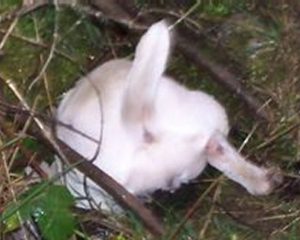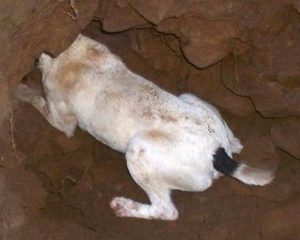Tail Docking
What it involves and why it is necessary:
Prophylactic docking (or tail shortening) is carried out for reasons of animal welfare across a range of working dogs. This includes a variety of terrier and gundog breeds which are used in connection with shooting, falconry, hunting and various types of pest control activities. It is a neccessary procedure, which is carried out in order to minimise and prevent tail injuries while working in dense cover and below ground, and in order to minimise the risk of far more major surgery at a later date.
The procedure itself is a relatively minor operation. It is carried out by a veterinary surgeon and normally takes place at around 72 hours after the puppy’s birth. So minor is the nature of the operation that it is carried out without the need for any form of anaesthetic and it is quite normal for the puppy to immediately resume suckling on the mother as if nothing had occurred. Once performed it provides a lifetime’s protection against far more serious injuries.
Tail injuries to undocked working dogs are extremely distressing and deeply painful. They can take a considerable time to heal, do continue to reoccur and in some instances may require part of the tail to be amputated under anaesthetic during later life.

Tail injuries to undocked working dogs are extremely distressing and deeply painful. They can take a considerable time to heal, do continue to reoccur and in some instances may require part of the tail to be amputated under anaesthetic during later life.
The risk of incurring tail injuries is far greater with working terriers than other breeds. Not only do they work above ground alongside the more traditional gundog breeds and fulfil a similar role, but they also work below ground as well.
Above ground (by virtue of their much smaller size) they seek out and pursue quarry in the densest of cover where other larger breeds cannot reach and in doing so place themselves at greater risk of incurring injuries. By their very nature they do so in a most determined manner and the risk of incurring tail injuries is further exacerbated by the terrier’s natural behaviour, which is not only to bark repeatedly at its quarry whilst in pursuit, but also to “flick” or “wag” its tail furiously when doing so.
.

The terrier’s role below ground is to seek out and flush its quarry. It does so by barking continually and throughout this process its tail is endlessly “wagging” or “flicking” from side to side. The closer it gets to its quarry, the more vigorously it wags its tail.
A correctly shortened tail is partly protected from injury by its position on the body and the size of the hole through which the terrier’s body can pass. Nevertheless it is not uncommon for a terrier to wear away the hairs at the end of its tail when working below ground, despite being correctly docked. Were the tail any longer it would be continuously beating against the sides of the holes, roots, rocks and any other obstructions encountered below ground, resulting in far more significant injuries.
Due to their relative size differences, a 2 inch tear or injury to the tail of a 12 to 14 pound terrier is a far more significant and difficult injury to heal and care for than a similar injury on a gundog weighing 35 to 55 pounds.
The Animal Welfare Act 2006 (summarised below) acknowledged the above and exempted working terriers, on animal welfare grounds, from the recent tail docking ban.
THE ANIMAL WELFARE ACT 2006 (summarised)
Overview
The law relating to the docking of dog’s tails changed in Wales on 28th March, England 6th April and Scotland 30th April 2007. An outright ban was imposed in Scotland. Whereas in England and Wales working terriers, along with certain other working gundog breeds, were exempted from the ban on welfare grounds.
The law in England and Wales is broadly similar except for the very important fact that in Wales the terrier exemption only applies to the following breeds – Jack Russell, Lakeland, Cairn and Norfolk (not combinations), whereas in England it applies to terriers of any type or combination of types.
The law in Scotland not only bans tail docking, but also makes it an offence to transport puppies from Scotland so they may be docked elsewhere.
These new laws also impose various restrictions on the exhibiting of dogs which have been docked under the Act and will affect exhibitors, show organisers and breeders in differing ways in England, Wales and Scotland. A certain amount of interpretation of the law which will only be made clear if it is tested in Court, however based upon the available information, we have attempted to clarify the complexities of the new law as far as possible. Broadly speaking these are:
The Impact on Working Terrier Shows:
Dogs Docked Before the Relevant Dates: These can continue to be shown at all shows in England, Wales and Scotland throughout their entire life and without any restrictions. Dogs Docked on or After the Relevant Dates: Irrespective of where they were docked, these dogs may not be exhibited at shows in England and Wales “where the public is admitted on payment of a fee”, except in order to demonstrate their working ability. They may however, be exhibited at shows in Scotland. In Scotland there are no showing restrictions. Whilst there is a total ban on tail docking in Scotland, there are no restrictions on the showing of legally docked dogs. So owners of legally docked dogs may show them at any show in Scotland, regardless of whether the public pay an admission fee. Events were the public are admitted upon payment of a fee: Those who organise or exhibit at shows in England or Wales where the public is admitted upon payment of a fee, should take into account the fact that it will be illegal for ANY dog docked after the relevant dates, to be exhibited at such events except to demonstrate their working ability. This applies even if the dog has been docked legally under the Act, or legally docked elsewhere.
Tail Docking – Working Dog Exemptions:
These new laws prohibit the docking of dogs’ tails in England, Wales and Scotland. In England and Wales there are certain limited (but differing) exemptions for specified types of working dogs, these will require appropriate certification and subsequent microchipping for identification purposes.
Certification requirements::
(1) A veterinary surgeon may certify that he has seen evidence that a dog is likely to be used for a specified type of work and is a dog of a specified type, where:-
- In England he is satisfied that the dam of the dog is of the following types;
- Hunt point retrieve breeds of any type or combination of types.
- Spaniels of any type or combination of types.
- Terriers of any type or combination of types.
- or in Wales he is satisfied that the puppy is one of the following breeds;
- Spaniel – English Springer Spaniel, Welsh Springer Spaniel, Cocker Spaniel, but not any combination of breeds.
- Terrier – Jack Russell Terrier, Cairn Terrier, Lakeland Terrier, Norfolk Terrier, but not any combination of breeds.
- HPRs of the following breeds: Braque Italian, Brittany, German Long Haired Pointer, German Short Haired Pointer, German Wire Haired Pointer, Hungarian Vizsla, Hungarian Wire Haired Vizsla, Italian Spinone, Spanish Water Dog, Weimaraner, Korthals Griffon, Slovakian Rough Haired Pointer, Large Munsterlander, Small Munsterlander.
- He reasonably believes that the dog is not more than 5 days old; and
- The owner of the dog, or a person he reasonably believes to be representing the owner, has shown him the evidence specified in paragraph (2).
(2) The evidence is
The dam of the dog.
a completed statement, signed and dated by the owner of the dog or by another person whom the veterinary surgeon to whom it is presented reasonably believes to be representing the owner, made in paragraph 3 of a certificate in the form prescribed in Schedule 2;
and one of the following—
where the dog is presented for certification on behalf of one of Her Majesty’s armed forces, or a body providing an emergency rescue service, or a police authority, or Her Majesty’s Prison Service, or an organisation contracted to provide custodial services on behalf of the Secretary of State, or Her Majesty’s Revenue & Customs, appropriate official identification;
evidence that the owner of the dog, or an agent or employee of the owner most likely to be using the dog, will be using the dog for work in connection with lawful pest control;
a current shotgun or firearm certificate issued to the owner of the dog, or to the agent or employee of the owner most likely to be using the dog for work in connection with the lawful shooting of animals;
a letter from a gamekeeper, a land-occupier (or his agent), a person with shooting rights, a shoot organiser, a club official, a person representing the National Working Terrier Federation, or a person engaged in lawful pest control, stating that the breeder of the dog whose tail is to be docked is known to him and that dogs bred by that breeder have been used (as the case may be) on his land, or in his shoot, or for pest control.
(3) Any certification given under paragraph (1) shall be made in paragraph 1 of a certificate in the form prescribed in Schedule 2.
All docking and microchipping must be carried out by a veterinary surgeon (but not necessarily the same one), the dogs must also be microchipped by the time they are 3 months old and their registration number entered on their docking certificate.
For full details of the Animal Welfare Act 2006 please click here.